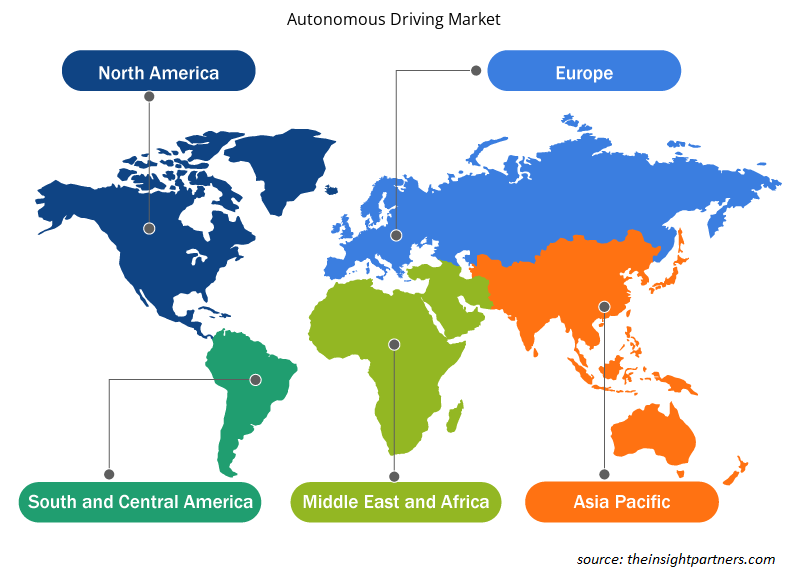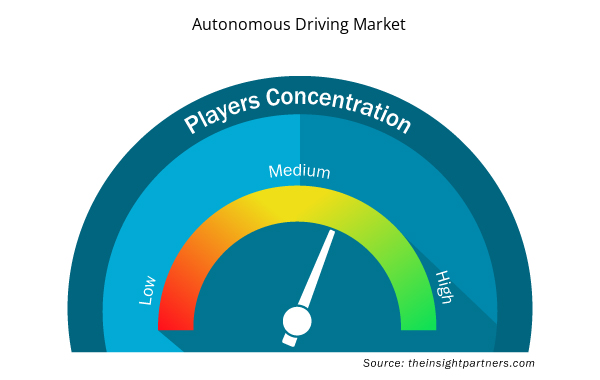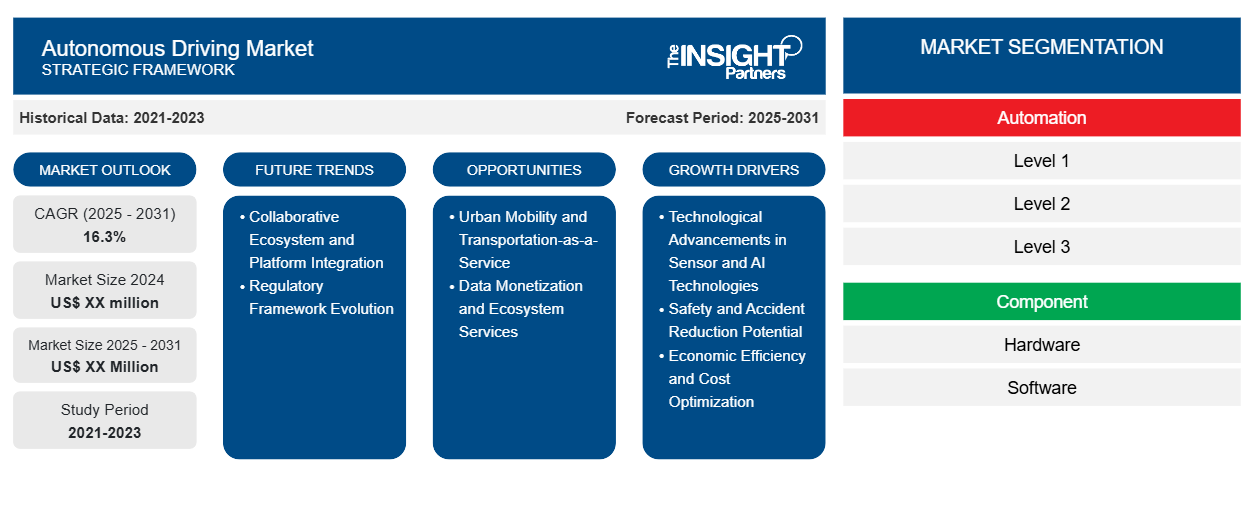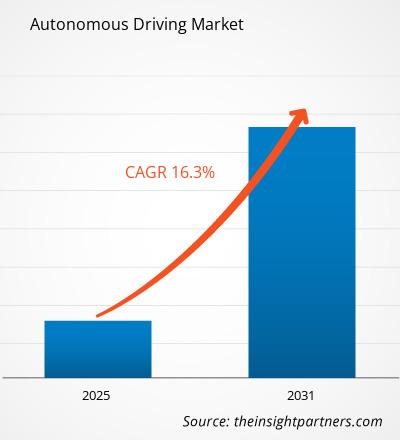من المتوقع أن يسجل سوق القيادة الذاتية معدل نمو سنوي مركب بنسبة 16.3٪ من عام 2023 إلى عام 2031، مع توسع حجم السوق من XX مليون دولار أمريكي في عام 2023 إلى XX مليون دولار أمريكي بحلول عام 2031.
تم تقسيم التقرير حسب مستوى الأتمتة (المستوى 1، المستوى 2، المستوى 3، المستوى 4، المستوى 5)، والمكون (الأجهزة، البرامج)، والتطبيق (المستهلك، مشاركة الركوب، مشاركة السيارة، النقل العام). تم تقسيم التحليل العالمي بشكل أكبر على المستوى الإقليمي والدول الرئيسية. يقدم التقرير القيمة بالدولار الأمريكي للتحليل والشرائح المذكورة أعلاه.
غرض التقرير
يهدف تقرير سوق القيادة الذاتية الصادر عن The Insight Partners إلى وصف المشهد الحالي والنمو المستقبلي وأهم العوامل الدافعة والتحديات والفرص. وسيوفر هذا رؤى لمختلف أصحاب المصلحة في الأعمال التجارية، مثل:
- مزودي/مصنعي التكنولوجيا: لفهم ديناميكيات السوق المتطورة ومعرفة فرص النمو المحتملة، وتمكينهم من اتخاذ قرارات استراتيجية مستنيرة.
- المستثمرون: إجراء تحليل شامل للاتجاهات فيما يتعلق بمعدل نمو السوق، وتوقعات السوق المالية، والفرص المتاحة عبر سلسلة القيمة.
- الهيئات التنظيمية: لتنظيم السياسات ومراقبة الأنشطة في السوق بهدف تقليل الانتهاكات والحفاظ على ثقة المستثمرين والحفاظ على سلامة السوق واستقرارها.
تجزئة سوق القيادة الذاتية
الأتمتة
- المستوى 1
- المستوى الثاني
- المستوى 3
- المستوى الرابع
- المستوى 5
عنصر
- الأجهزة
- برمجة
طلب
- مستهلك
- مشاركة الركوب
- مشاركة السيارة
- النقل العام
الجغرافيا
- أمريكا الشمالية
- أوروبا
- آسيا والمحيط الهادئ
- أمريكا الجنوبية والوسطى
- الشرق الأوسط وأفريقيا
الجغرافيا
- أمريكا الشمالية
- أوروبا
- آسيا والمحيط الهادئ
- أمريكا الجنوبية والوسطى
- الشرق الأوسط وأفريقيا
قم بتخصيص هذا التقرير ليناسب متطلباتك
ستحصل على تخصيص لأي تقرير - مجانًا - بما في ذلك أجزاء من هذا التقرير، أو تحليل على مستوى الدولة، وحزمة بيانات Excel، بالإضافة إلى الاستفادة من العروض والخصومات الرائعة للشركات الناشئة والجامعات
- احصل على أهم اتجاهات السوق الرئيسية لهذا التقرير.ستتضمن هذه العينة المجانية تحليلاً للبيانات، بدءًا من اتجاهات السوق وحتى التقديرات والتوقعات.
عوامل نمو سوق القيادة الذاتية
- التطورات التكنولوجية في تقنيات الاستشعار والذكاء الاصطناعي: إن التحسينات السريعة في تقنيات الاستشعار مثل الليدار والرادار وأنظمة الكاميرات المتقدمة، جنبًا إلى جنب مع خوارزميات الذكاء الاصطناعي والتعلم الآلي المبتكرة، تعمل على تعزيز قدرات الإدراك واتخاذ القرار في المركبات ذاتية القيادة بشكل كبير. تمكن شبكات التعلم العميق الآن المركبات من معالجة البيانات البيئية المعقدة في جزء من الثانية، والتعرف على سيناريوهات الطريق الديناميكية والاستجابة لها بدقة وموثوقية غير مسبوقة، وبالتالي جعل القيادة الذاتية الكاملة أقرب إلى الواقع.
- السلامة وإمكانية الحد من الحوادث: تعد المركبات ذاتية القيادة بتخفيضات كبيرة في حوادث المرور الناجمة عن الخطأ البشري، والذي يمثل أكثر من 90٪ من حوادث الطرق الحالية. تعمل أنظمة مساعدة السائق المتقدمة (ADAS) وتقنيات القيادة الذاتية الكاملة على الاستفادة من مراقبة أجهزة الاستشعار المستمرة وأوقات رد الفعل الأسرع والقضاء على القيود البشرية مثل التعب وتشتيت الانتباه والقيادة تحت تأثير الكحول، مما يقدم حجة أمان مقنعة تتردد صداها لدى المستهلكين وشركات التأمين والهيئات التنظيمية.
- الكفاءة الاقتصادية وتحسين التكلفة: توفر منظومة القيادة الذاتية فوائد اقتصادية كبيرة من خلال خفض تكاليف العمالة، وتحسين إدارة الأسطول، وتعزيز كفاءة الوقود. يمكن لشركات النقل والخدمات اللوجستية خفض النفقات التشغيلية بشكل كبير من خلال نشر المركبات ذاتية القيادة التي تعمل على تحسين المسارات، وتقليل وقت الخمول، والعمل بأداء ثابت. إن إمكانية التشغيل على مدار الساعة طوال أيام الأسبوع وخفض تكاليف الصيانة تجعل تكنولوجيا القيادة الذاتية استثمارًا جذابًا بشكل متزايد.
اتجاهات مستقبل سوق القيادة الذاتية
- النظام البيئي التعاوني وتكامل المنصات: يشهد سوق القيادة الذاتية تعاونًا غير مسبوق بين مصنعي السيارات وشركات التكنولوجيا ومطوري البرامج. وتظهر شراكات استراتيجية لتجميع الموارد ومشاركة الخبرة التكنولوجية وإنشاء منصات قيادة ذاتية شاملة. ويعمل هذا الاتجاه على تسريع الابتكار، وخفض تكاليف التطوير الفردية، وتمكين اختراق السوق بشكل أسرع من خلال المعايير التكنولوجية المشتركة والأنظمة المتوافقة.
- تطور الإطار التنظيمي: تتكيف البيئات التنظيمية العالمية بشكل تدريجي لاستيعاب تقنيات المركبات ذاتية القيادة، وتطوير أطر شاملة توازن بين الابتكار والسلامة العامة. وتعمل الحكومات على إنشاء مناطق اختبار متخصصة، وتحديث قوانين المرور، ووضع إرشادات واضحة لنشر المركبات ذاتية القيادة. ويوفر هذا المشهد التنظيمي المتطور مسارات أكثر وضوحًا للتنفيذ التجاري وثقة المستثمرين في تقنيات القيادة الذاتية.
فرص سوق القيادة الذاتية
- التنقل الحضري والنقل كخدمة: تقدم المركبات ذاتية القيادة فرصًا تحويلية في مجال التنقل الحضري، وخاصة من خلال نماذج المركبات ذاتية القيادة المشتركة. يمكن للبيئات الحضرية الكثيفة الاستفادة من تقنيات القيادة الذاتية لإنشاء شبكات نقل فعّالة عند الطلب تعمل على الحد من الازدحام وخفض الانبعاثات الكربونية وتوفير حلول تنقل متاحة لشرائح سكانية متنوعة، بما في ذلك كبار السن والأفراد ذوي الإعاقة.
- استثمار البيانات وخدمات النظم الإيكولوجية: تولد ثورة القيادة الذاتية كميات غير مسبوقة من البيانات في الوقت الفعلي، مما يخلق فرصًا مربحة لاستغلال البيانات والخدمات ذات القيمة المضافة. وبعيدًا عن النقل، يمكن أن تصبح المركبات ذاتية القيادة منصات متنقلة لجمع البيانات، مما يوفر رؤى للتخطيط الحضري، ونماذج التأمين، والصيانة التنبؤية، وتجارب المستخدم الشخصية، وبالتالي توسيع تدفقات الإيرادات إلى ما هو أبعد من نماذج النقل التقليدية.
رؤى إقليمية حول سوق القيادة الذاتية
لقد قام المحللون في Insight Partners بشرح الاتجاهات والعوامل الإقليمية المؤثرة على سوق القيادة الذاتية طوال فترة التوقعات بشكل شامل. يناقش هذا القسم أيضًا قطاعات سوق القيادة الذاتية والجغرافيا في جميع أنحاء أمريكا الشمالية وأوروبا ومنطقة آسيا والمحيط الهادئ والشرق الأوسط وأفريقيا وأمريكا الجنوبية والوسطى.

- احصل على البيانات الإقليمية المحددة لسوق القيادة الذاتية
نطاق تقرير سوق القيادة الذاتية
| سمة التقرير | تفاصيل |
|---|---|
| حجم السوق في عام 2023 | XX مليون دولار أمريكي |
| حجم السوق بحلول عام 2031 | XX مليون دولار أمريكي |
| معدل النمو السنوي المركب العالمي (2023 - 2031) | 16.3% |
| البيانات التاريخية | 2021-2022 |
| فترة التنبؤ | 2024-2031 |
| القطاعات المغطاة | بواسطة الأتمتة
|
| المناطق والدول المغطاة | أمريكا الشمالية
|
| قادة السوق وملفات تعريف الشركات الرئيسية |
|
كثافة اللاعبين في سوق القيادة الذاتية: فهم تأثيرها على ديناميكيات الأعمال
يشهد سوق القيادة الذاتية نموًا سريعًا، مدفوعًا بالطلب المتزايد من المستخدم النهائي بسبب عوامل مثل تفضيلات المستهلكين المتطورة والتقدم التكنولوجي والوعي المتزايد بفوائد المنتج. ومع ارتفاع الطلب، تعمل الشركات على توسيع عروضها والابتكار لتلبية احتياجات المستهلكين والاستفادة من الاتجاهات الناشئة، مما يؤدي إلى زيادة نمو السوق.
تشير كثافة اللاعبين في السوق إلى توزيع الشركات أو المؤسسات العاملة في سوق أو صناعة معينة. وهي تشير إلى عدد المنافسين (اللاعبين في السوق) الموجودين في مساحة سوق معينة نسبة إلى حجمها أو قيمتها السوقية الإجمالية.
الشركات الرئيسية العاملة في سوق القيادة الذاتية هي:
- شركة دايملر ايه جي
- بايدو
- جنرال موتورز
- تويوتا
- تسلا
- هوندا
إخلاء المسؤولية : الشركات المذكورة أعلاه ليست مرتبة بأي ترتيب معين.

- احصل على نظرة عامة على أهم اللاعبين الرئيسيين في سوق القيادة الذاتية
نقاط البيع الرئيسية
- التغطية الشاملة: يغطي التقرير بشكل شامل تحليل المنتجات والخدمات والأنواع والمستخدمين النهائيين لسوق القيادة الذاتية، مما يوفر صورة شاملة.
- تحليل الخبراء: تم تجميع التقرير على أساس الفهم العميق لخبراء الصناعة والمحللين.
- معلومات محدثة: يضمن التقرير أهمية الأعمال التجارية بسبب تغطيته للمعلومات الحديثة واتجاهات البيانات.
- خيارات التخصيص: يمكن تخصيص هذا التقرير لتلبية متطلبات العملاء المحددة وبما يتناسب مع استراتيجيات العمل بشكل مناسب.
وبالتالي، يمكن أن يساعد تقرير البحث حول سوق القيادة الذاتية في تمهيد الطريق لفك شفرة وفهم سيناريو الصناعة وآفاق النمو. ورغم وجود بعض المخاوف المشروعة، فإن الفوائد الإجمالية لهذا التقرير تميل إلى التفوق على العيوب.
- التحليل التاريخي (سنتان)، السنة الأساسية، التوقعات (7 سنوات) مع معدل النمو السنوي المركب
- تحليل PEST و SWOT
- حجم السوق والقيمة / الحجم - عالميًا وإقليميًا وقطريًا
- الصناعة والمنافسة
- مجموعة بيانات Excel



Report Coverage
Revenue forecast, Company Analysis, Industry landscape, Growth factors, and Trends

Segment Covered
This text is related
to segments covered.

Regional Scope
North America, Europe, Asia Pacific, Middle East & Africa, South & Central America

Country Scope
This text is related
to country scope.
الأسئلة الشائعة
Some of the customization options available based on the request are an additional 3-5 company profiles and country-specific analysis of 3-5 countries of your choice. Customizations are to be requested/discussed before making final order confirmation, as our team would review the same and check the feasibility.
Shift Towards Enhanced Safety Features is the key future trend of the Autonomous Driving Market
The leading players operating in the Autonomous Driving Market include Daimler AG, Baidu, General Motors, Toyota, Tesla, Honda, ZOOX, Audi AG, Ford, NVIDIA
The report can be delivered in PDF/PPT format; we can also share excel dataset based on the request.
The Autonomous Driving Market is estimated to witness a CAGR of 16.3% from 2023 to 2031
The major factors driving the Autonomous Driving Market are:Technological Advancements#Increasing Consumer Demand for Connectivity
Trends and growth analysis reports related to Automotive and Transportation : READ MORE..
The List of Companies
The Insight Partners performs research in 4 major stages: Data Collection & Secondary Research, Primary Research, Data Analysis and Data Triangulation & Final Review.
- Data Collection and Secondary Research:
As a market research and consulting firm operating from a decade, we have published and advised several client across the globe. First step for any study will start with an assessment of currently available data and insights from existing reports. Further, historical and current market information is collected from Investor Presentations, Annual Reports, SEC Filings, etc., and other information related to company’s performance and market positioning are gathered from Paid Databases (Factiva, Hoovers, and Reuters) and various other publications available in public domain.
Several associations trade associates, technical forums, institutes, societies and organization are accessed to gain technical as well as market related insights through their publications such as research papers, blogs and press releases related to the studies are referred to get cues about the market. Further, white papers, journals, magazines, and other news articles published in last 3 years are scrutinized and analyzed to understand the current market trends.
- Primary Research:
The primarily interview analysis comprise of data obtained from industry participants interview and answers to survey questions gathered by in-house primary team.
For primary research, interviews are conducted with industry experts/CEOs/Marketing Managers/VPs/Subject Matter Experts from both demand and supply side to get a 360-degree view of the market. The primary team conducts several interviews based on the complexity of the markets to understand the various market trends and dynamics which makes research more credible and precise.
A typical research interview fulfils the following functions:
- Provides first-hand information on the market size, market trends, growth trends, competitive landscape, and outlook
- Validates and strengthens in-house secondary research findings
- Develops the analysis team’s expertise and market understanding
Primary research involves email interactions and telephone interviews for each market, category, segment, and sub-segment across geographies. The participants who typically take part in such a process include, but are not limited to:
- Industry participants: VPs, business development managers, market intelligence managers and national sales managers
- Outside experts: Valuation experts, research analysts and key opinion leaders specializing in the electronics and semiconductor industry.
Below is the breakup of our primary respondents by company, designation, and region:

Once we receive the confirmation from primary research sources or primary respondents, we finalize the base year market estimation and forecast the data as per the macroeconomic and microeconomic factors assessed during data collection.
- Data Analysis:
Once data is validated through both secondary as well as primary respondents, we finalize the market estimations by hypothesis formulation and factor analysis at regional and country level.
- Macro-Economic Factor Analysis:
We analyse macroeconomic indicators such the gross domestic product (GDP), increase in the demand for goods and services across industries, technological advancement, regional economic growth, governmental policies, the influence of COVID-19, PEST analysis, and other aspects. This analysis aids in setting benchmarks for various nations/regions and approximating market splits. Additionally, the general trend of the aforementioned components aid in determining the market's development possibilities.
- Country Level Data:
Various factors that are especially aligned to the country are taken into account to determine the market size for a certain area and country, including the presence of vendors, such as headquarters and offices, the country's GDP, demand patterns, and industry growth. To comprehend the market dynamics for the nation, a number of growth variables, inhibitors, application areas, and current market trends are researched. The aforementioned elements aid in determining the country's overall market's growth potential.
- Company Profile:
The “Table of Contents” is formulated by listing and analyzing more than 25 - 30 companies operating in the market ecosystem across geographies. However, we profile only 10 companies as a standard practice in our syndicate reports. These 10 companies comprise leading, emerging, and regional players. Nonetheless, our analysis is not restricted to the 10 listed companies, we also analyze other companies present in the market to develop a holistic view and understand the prevailing trends. The “Company Profiles” section in the report covers key facts, business description, products & services, financial information, SWOT analysis, and key developments. The financial information presented is extracted from the annual reports and official documents of the publicly listed companies. Upon collecting the information for the sections of respective companies, we verify them via various primary sources and then compile the data in respective company profiles. The company level information helps us in deriving the base number as well as in forecasting the market size.
- Developing Base Number:
Aggregation of sales statistics (2020-2022) and macro-economic factor, and other secondary and primary research insights are utilized to arrive at base number and related market shares for 2022. The data gaps are identified in this step and relevant market data is analyzed, collected from paid primary interviews or databases. On finalizing the base year market size, forecasts are developed on the basis of macro-economic, industry and market growth factors and company level analysis.
- Data Triangulation and Final Review:
The market findings and base year market size calculations are validated from supply as well as demand side. Demand side validations are based on macro-economic factor analysis and benchmarks for respective regions and countries. In case of supply side validations, revenues of major companies are estimated (in case not available) based on industry benchmark, approximate number of employees, product portfolio, and primary interviews revenues are gathered. Further revenue from target product/service segment is assessed to avoid overshooting of market statistics. In case of heavy deviations between supply and demand side values, all thes steps are repeated to achieve synchronization.
We follow an iterative model, wherein we share our research findings with Subject Matter Experts (SME’s) and Key Opinion Leaders (KOLs) until consensus view of the market is not formulated – this model negates any drastic deviation in the opinions of experts. Only validated and universally acceptable research findings are quoted in our reports.
We have important check points that we use to validate our research findings – which we call – data triangulation, where we validate the information, we generate from secondary sources with primary interviews and then we re-validate with our internal data bases and Subject matter experts. This comprehensive model enables us to deliver high quality, reliable data in shortest possible time.


 احصل على عينة مجانية لهذا التقرير
احصل على عينة مجانية لهذا التقرير